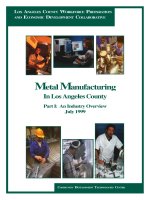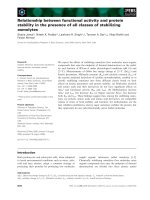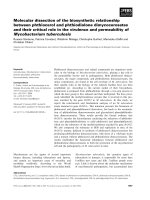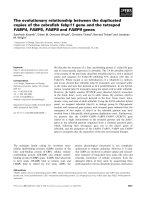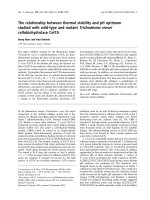the valued relationship between workforce training and economic development a correlation study
Bạn đang xem bản rút gọn của tài liệu. Xem và tải ngay bản đầy đủ của tài liệu tại đây (449.84 KB, 155 trang )
THE VALUED RELATIONSHIP BETWEEN WORKFORCE TRAINING AND
ECONOMIC DEVELOPMENT: A CORRELATION STUDY
By
Kevin A. Cojanu
JOHN DeNIGRIS, Ph.D., Faculty Mentor and Chair
JOHNNY MORRIS, Ph.D., Committee Member
ADOLFO GORRIARAN, Ph.D., Committee Member
Kurt Linberg, Ph.D., Dean, School of Business & Technology
A Dissertation Presented in Partial Fulfillment
Of the Requirements for the Degree
Doctor of Philosophy
Capella University
December 2007
UMI Number: 3288820
3288820
2008
UMI Microform
Copyright
All rights reserved. This microform edition is protected against
unauthorized copying under Title 17, United States Code.
ProQuest Information and Learning Company
300 North Zeeb Road
P.O. Box 1346
Ann Arbor, MI 48106-1346
by ProQuest Information and Learning Company.
© Kevin A. Cojanu, 2007
Abstract
The purpose of this study was to determine if workforce development has an impact on
changing the economic growth of rural communities in the state of Florida. Currently
there are no consistent strategies for developing workforce ready individuals in the many
rural communities of the United States. This research provides data as a point of
correlation for defining how workforce development affects the business opportunities
for economic growth in rural communities in Florida. This study develops ideas
regarding the impact of workforce development programs based on the two age
categories of “45 and Under” and “Over 45”, as this relates to the advancement of
economic growth of rural communities in the state of Florida. Participants for this study
were drawn from the members in the National Rural Economic Developers Association
(NREDA). A researcher-designed questionnaire was used to determine self-reported
viewpoints, divided by the two age categories above, regarding business, community, and
workforce issues as related to economic development in rural communities that can be
applied to the state of Florida. The results indicated that those National Rural Economic
Developers Association (NREDA) members who self-identified in the researcher’s
survey as “45 and Under” and those who self-identified as “Over 45” recognize that (a)
businesses have an influence on the workforce development levels in rural communities
as this impacts economic development, (b) communities, themselves, have an influence
on the workforce development levels in rural communities as this impacts economic
development, and (c) community workforce development agencies and educational
systems focused on developing workforce ready individuals within rural communities do
have an impact on economic development.
Dedication
This dissertation is dedicated to the most important person in my life, Susan.
Susan’s love, caring, dedication, and just plain old patience of a saint made all of this
possible. Susan was my rock, my motivation, and my love. She provided me with the
stamina to be something more than I thought I could be. In this dedication, I can only tell
her that the deep love we have for each other has helped us to overcome the hardships we
faced. This has made us stronger together and forged a bond that is unbreakable – I love
you Suzy!
Acknowledgments
There are many people that need to be part of this acknowledgement. First and
foremost, my mother, Marlene, who forever pushed me to be all I could be in life, and not
because she wanted a doctor in the family. My father, Stan, who will not see the
successful completion of this milestone because of his passing in 2005, but I know he is
watching with pride. I truly need to acknowledge the unwavering support of my in-laws,
Joni and Charlie. They have supported my every effort and my direction in this world,
and Charlie always had a joke or story that put everything into perspective. My friend,
my brother in this world, Randy, who was always asking how it was going and presented
me with a sounding board when life got tough. In every aspect of life, we meet people
that become family whom you love and care for, unconditionally. Trisha and Erik, of the
Hornitos family, have become just such family. I cannot fail to mention Dave and Loree,
who left me this year, 2007. I missed their tough love, but their faith helped me through
some difficult times. My daughter, Megan, who I tried to set an example for in that life is
full of challenges, but one must persevere to see success. I have great hopes for her
future. I cannot forget my Aunt Angela in this dedication. I believe her love, her
attention, and her example created the desire I had to learn all that I could, no matter
what. My Little Grandpa, gone these many years, still provides the life lessons I have
daily in my life. I know he is standing proud looking upon my accomplishment and
telling everyone “That’s my Grandson.”
I wish to acknowledge my superior dissertation committee, Drs. John DeNigris,
Johnny Morris, and Adolfo Gorriaran for all of their guidance, patience, and well-timed
encouragement. Also, I would like to acknowledge Dr. Susan Pettine who was an
excellent sounding board when the well ran dry. Her profound knowledge and ideas
allowed my creativity to flow.
Table of Contents
Acknowledgments iv
List of Tables ix
CHAPTER 1: INTRODUCTION 1
Introduction to the Problem 1
Statement of the Problem 3
Purpose of the Study 5
Rationale 6
Research Questions and Hypothesis 7
Significance of the Study 7
Definition of Terms 9
Assumptions 10
Limitations 11
Nature of the Study 11
Organization of the Remainder of the Study 12
CHAPTER 2: LITERATURE REVIEW 14
Introduction 14
Overview 14
Community Involvement 16
Workforce Development Associations 31
Business Involvement 42
CHAPTER 3: METHODOLOGY 51
Introduction 51
Foundation for the Methodology 51
Research Design Strategy 54
Sampling Design: Population and Sample 55
Measures 56
Data Collection Procedures 57
Pilot Testing 58
Data Analysis Procedures 58
Limitations of Methodology 59
Internal Validity 60
External Validity 61
Expected Findings 61
Ethical Issues 62
Conclusion 63
CHAPTER 4: DATA COLLECTION AND ANALYSIS 64
Introduction 64
Review of Research Questions and Hypotheses 64
Review of Data Collection 65
Pilot Study 66
Findings Related to Hypothesis 1 67
Question 1 67
Question 2 69
Question 3 70
Question 4 72
Question 5 74
Overall Discussion of Hypothesis 1 Findings 76
Findings Related to Hypothesis 2 76
Question 1 77
Question 2 78
Question 3 80
Question 4 82
Question 5 84
Overall Discussion of Hypothesis 2 Findings 85
Findings Related to Hypothesis 3 86
Question 1 86
Question 2 88
Question 3 89
Question 4 91
Question 5 93
Overall Discussion of Hypothesis 3 Findings 95
Summary of Data Collection and Analysis 95
CHAPTER 5. RESULTS, CONCLUSIONS, AND RECOMMENDATIONS 98
Introduction 98
Summary of the Study 98
Discussion of the Results 99
Hypothesis 1 99
Hypothesis 2 101
Hypothesis 3 102
Conclusions 104
Recommendations for Future Research 105
REFERENCES 107
APPENDIX A: SURVEY QUESTIONS AND INFORMED CONSENT 117
APPENDIX B: SURVEY DATA: HYPOTHESIS #1 126
APPENDIX C: SURVEY DATA: HYPOTHESIS #2 131
APPENDIX D: SURVEY DATA: HYPOTHESIS #3 136
List of Tables
Table 1. Survey Response 66
Table 2. Participant Age Categories as Recorded by the Researcher’s Survey
Instrument 66
Table 3. Question 1 Age Categories and Responses 68
Table 4. Question 2 Age Categories and Responses 69
Table 5. Question 3 Age Categories and Responses 71
Table 6. Question 4 Age Categories and Responses 73
Table 7. Question 5 Age Categories and Responses 75
Table 8. Question 1 Age Categories and Responses 77
Table 9. Question 2 Age Categories and Responses 79
Table 10. Question 3 Age Categories and Responses 81
Table 11. Question 4 Age Categories and Responses 82
Table 12. Question 5 Age Categories and Responses 84
Table 13. Question 1 Age Categories and Responses 87
Table 14. Question 2 Age Categories and Responses 88
Table 15. Question 3 Age Categories and Responses 90
Table 16. Question 4 Age Categories and Responses 92
Table 17. Question 5 Age Categories and Responses 94
Table B1. Hypothesis 1, Question 1 126
Table B2. Hypothesis 1, Question 2 127
Table B3. Hypothesis 1, Question 3 128
Table B4. Hypothesis 1, Question 4 129
Table B5. Hypothesis 1, Question 5 130
Table C1. Hypothesis 2, Question 1 131
Table C2. Hypothesis 2, Question 2 132
Table C3. Hypothesis 2, Question 3 133
Table C4. Hypothesis 2, Question 4 134
Table C5. Hypothesis 2, Question 5 135
Table D1. Hypothesis 3, Question 1 136
Table D2. Hypothesis 3, Question 2 137
Table D3. Hypothesis 3, Question 3 138
Table D4. Hypothesis 3, Question 4 139
Table D5. Hypothesis 3, Question 5 140
CHAPTER 1: INTRODUCTION
Introduction to the Problem
The state of Florida has put forth the Rural Economic Development Initiative
(REDI) to assist rural Florida communities to become more viable economically (Florida
Statute 288.0656). Section 2 Article (a) says:
Economic distress" means conditions affecting the fiscal and economic viability
of a rural community, including such factors as low per capita income, low per
capita taxable values, high unemployment, high underemployment, low weekly
earned wages compared to the state average, low housing values compared to the
state average, high percentages of the population receiving public assistance, high
poverty levels compared to the state average, and a lack of year-round stable
employment opportunities (Florida Statute 288.0656) .
In addition Section seven states:
… A rural area of critical economic concern must be a rural community, or a
region composed of such, that has been adversely affected by an extraordinary
economic event or a natural disaster or that presents a unique economic
development opportunity of regional impact that will create more than 1,000 jobs
over a 5-year period (Florida Statute 288.0656).
Workforce development in rural communities of Florida is not treated equally
across the state because there are no viable programs that can properly educate or train
the existing workforce to advance the viability of the community (Garlich & Tesinsky,
2005). This research study evaluates the impact of an unskilled workforce on business
opportunities for economic growth in rural communities in Florida.
Workforce Training and Economic Development 2
Ulrich Research (2002) provided research that determined workforce availability
compared to workforce development opportunities in Highlands County Florida were at
risk based on the level of training and education within the available workforce.
Davenport (2006) suggests that according to corporate executives the United States must
increase the education and skills of rural and urban communities in order to remain
competitive in retaining jobs. Dychtwald, Erickson, and Morrison (2006) cite that fewer
degreed people in the workforce significantly influence economic growth of business in
urban and rural communities. There appears to be fewer and fewer skilled workers to
address the needs of corporations in leadership and problems solving to meet the
demands of the global market (Davenport, 2006).
Highlands County Florida is a region of Florida that is designated agricultural.
Highlands County Florida’s focus is the citrus and cattle industries, which is beginning to
fade due to foreign competition (Pfeifer, 2006). The shift away from agriculture is
beginning to have an impact on the population of the Highlands County Florida and there
is a need to develop the existing workforce to become viable for other business and
industry to maintain economic development opportunities (Dalton, 2004). Ulrich
Research in September of 2000 indicated that based on the estimated 99,718 adults 18
and over that less then 12% have a college education, 7% have some specific trades
training, and 30% have high school diplomas (Ulrich Research, 2000). The range of
career opportunities reside in office and clerical, service related positions, and a large mix
related to agriculture in numerous forms (Ulrich Research, 2000).
One example of the relationship of workforce training linkages and economic
development is in Massachusetts, where roughly 1.1 million workers have not obtained,
Workforce Training and Economic Development 3
or have the means to obtain needed skills to support economic growth (Business West
Editorial, 2005). These workers will become an unskilled labor force that will be
recognized as at-risk for low-income output and impact the economic viability of the
economic position of the United States (Sperling, 2005). At the current rate, Both China
and India will annually graduate five times the number of engineers compared to the
United States (Sperling, 2005). In the new global economy, foreign labor is effectively
replacing the United States as the premier labor market.
Kastsinas and Moeck (2002) compare the ‘have’ and the ‘have–nots’ in the
ability to offer technology availability and training to different communities. A study by
Kastsinas and Moeck (2002) outlined that most rural communities struggle to be
technologically perceptive because of the economic resources available to them. Rural
colleges face the same issues because of available funding to develop and deliver new
workforce training programs. Therefore, these communities are behind in developing
into economic centers that focus on developing workforce skills at the earliest possible
learning levels and or delivering workforce training. Kastsinas and Moeck (2003)
expands on this position to promote a review of current funding models for college
tuition. This review should account for the real cost of tuition including items such as
childcare, transportation, and living expenses.
Statement of the Problem
The lack of a skilled workforce is having an impact on businesses and the
economic development of rural communities in the State of Florida. Highlands County
Florida is one example that finds the most educated of the available workforce making on
the range of $26,000 to $32,000 in 2000 according to the Ulrich Research (2000) study.
Workforce Training and Economic Development 4
Additionally, the highest paid positions make up less than 12% of the total population of
Highlands County Florida (Ulrich Research, 2000). Some of the conditions can relate to
the actual level of skills that are available from high school and college graduates
entering into the workforce. In some cases workforce resources do not have the
knowledge to contribute to the business objectives that relate to the growth of local and
relocated businesses (Andersson & Karlsson, 2007).
The Academy of Management Review (Tallman, Jenkins, Henry & Pinch, 2004)
promotes the definition of Industrial District as a single focused geography to promote
the industry of choice. This definition identifies that the knowledge sharing for the
development of specialized workforces occurs at all levels of business, education, and
local government to develop the Industrial District to meet the current and future needs of
the specific industry.
Markusen (2004) promotes the concept of ’Industrial Targeting’ as a form of
industrial districting. The concept looks at the methodology of corporations building a
strategic plan that ideally looks for the logistical attributes that exist in a community and
then begins the process of knowledge sharing with community and education leaders to
begin the potential transformation. Markusen (2004) warns that this methodology is not
always the most effective method of creating economic growth in a community.
Markusen’s reasoning resonates around the theory that much of the available
demographics for a community may lack consistency and validity.
Patrucco (2003) introduces the concept of agglomeration as the development of
loosely connected communities that offer the impression of a solid workforce
development program that could support the needs of one or multiple industries. The
Workforce Training and Economic Development 5
benefit to the economic growth is the knowledge and training of the workforce. These
agglomerations provide effectively for the growth of businesses into three different
districts; the actual industry it supports, the technical support services, and the
community services that are provided to the workforce. As Patrucco (2003) suggests, the
community develops, hence bringing economic growth as a natural progression for
supporting the industrial district with a well-trained workforce.
Workforce investment planning appears to play a crucial role in the success or
failure of economic development. To understand how workforce training and
development influences to economic growth it will be necessary to understand the
relationship and its presumed effects.
Purpose of the Study
The purpose of this study was to determine what degree of impact workforce
development has on changing the economic growth of rural communities in the State of
Florida. Currently there are no consistent strategies for developing workforce ready
individuals in the many rural communities of the United States. This research provides
data as a point of correlation for defining how workforce development affects the
business opportunities for economic growth in rural communities in Florida.
Swager (2000) defines economic development as a method of utilizing resources
such as land, buildings, and people to provide for underdeveloped regions and countries.
Sperling (2005) states:
Over the past two decades, the share of workers with at least a high school degree
grew by 19 percent; over the next two decades, it will grow by only 4 percent. At
the same time, high-skilled technical jobs have grown five times faster than the
Workforce Training and Economic Development 6
population since 1980. Unless we expect massive new immigration or increased
fertility rates, we will need to increase the pool of highly skilled workers or face a
growing labor shortage (p.137).
Sperling (2005) implies there is a lack of highly skilled workers to support the
potential requirements of businesses in the United States. This research study examines
how a dwindling skilled workforce could influence business and economic growth. The
research study also focuses on the levels of education within the workforce and the
possible impact on businesses and economic growth of local communities within the
United States. To provide the necessary workforce for a business and to contribute to
economic growth, businesses may need to contribute to the learning outcomes and
potentially work with the community (or country) to develop that potential workforce
resource (Preparing for tomorrow through education and workforce development, 2006).
Specifically, economic development is a focus for developing economic growth
with no real specific boundaries or limitation. Economic development has assumed the
role as one of the dominating issues in the world today. There is a great deal to be said
for acting global and working local when the competition for economic business has no
country or continent boundaries, but the maintenance of global business relies solely on
available resources within the village, town, city or metropolitan urban center (Koehler &
Wurzel, 2003).
Rationale
This study adds to the body of knowledge as it relates to the development of
workforce skills and its possible impact on the economic development of the
communities they serve. Economic development is a global movement driven by local
Workforce Training and Economic Development 7
business and communities as a point of survival for future generations (Holliday, 2006).
This study provides information about the role businesses, communities, government,
education, and workforce development agencies have in creating programs for
encouraging workforce development to enhance the economic development of a given
community and/or region.
Research Questions and Hypothesis
A sample survey of the National Rural Economic Developers Association
(NREDA) members was conducted, as they represent the interest of the rural
communities in Florida and the United States. This association represents the leadership
of rural communities and can effectively provide knowledge and validity to the research.
These research propositions were framed by these research questions:
1) Does business influence the level of workforce development in rural
communities to impact economic development?
2) Do communities influence level of workforce development to impact
economic development?
3) Do community workforce development agencies and educational
systems focused on developing workforce ready individuals’ impact
economic development?
Harvard Economist, Ed Glaeser outlines the need for communities, businesses,
education, and governments to come together and positively impact the economic growth
of communities big and small (Bowles, 2005).
Significance of Study
Workforce Training and Economic Development 8
In the Southeastern United States the wages per-capita are the lowest in the
nation. Florida is one of the largest states in the geography and it represents about 35%
of the total workforce in the Southeast. The quality of workforce development is
dramatically impacted in rural areas and hit harder with potentially fewer opportunities
(Shuptrine, 2006).
The Work Readiness Credential is a voluntary program created by the U.S.
Department of Commerce to promote a ready workforce. Florida is a participant, but
does not have a solid base for running the program in urban or rural communities. The
program does not focus on developing workforce skills in specific areas. It will make the
resource a better candidate for providing basic job skills (Olson, 2006).
Workforce development is rural communities like Highlands County Florida
suffer from a potential lack of direction in developing programs to educate and train the
workforce to open opportunities for business development and relocation. Some
communities establish themselves as a leader in specific industry clusters. The ability to
promote a specialization based on workforce skills works to establish the community and
draw the interest of businesses in that industry (Romanelli & Khessina, 2005). The
challenge to meet any specific industry criteria may relate to the demographics of the
community, which provide a workforce that is trained and or trainable with the required
business skills. In cluster opportunities, communities look to the business seeking to
locate to assist in the training process (Jeter, 2004).
This study seeks to create new avenues of opportunity for businesses and
communities to evaluate current workforce development activities and determine if the
specifics of the strategy are in the best interest of the workforce being developed and
Workforce Training and Economic Development 9
hence the impact to the economic position of the community. Developing and
redeveloping a workforce strategy could keep communities like Highlands County
Florida in the forefront of the business needs of specialized industries solely based on the
development of a workforce that is equipped to support any possible requirements.
Definition of Terms
There are several key terms used in this study that require a clear definition. They
are as follows:
Workforce Development: Knowledge and skills that relate specifically to the work
delivered in a community. Managing strategy to maintain the viability of business based
on the available labor force skills (Voorhees & Harvey, 2005).
Economic development: The combination of specific elements education,
employment opportunities grow, income rises, innovation in business becomes the rule,
and there is a steady increase in productivity (Schweke, 2000).
Economic growth: Utilizing the Endogenous Growth Theory, which measures
growth based on employment numbers and income growth among the workforce, this
includes the monitoring of the human capital components for education, training and
workforce-ready individuals. Additionally, the theory includes the impact of government
policy, trade, and local and foreign investment (Ericsson & Irandoust, 2000).
Secondary institutions: Comprehensive high schools that cover Basic English,
Mathematics, Social Studies, Science, and some basic vocational instruction.
Post-secondary institution: Higher education focusing on providing specific
vocations by way of degree in a specialized subject matter that can be applied to a job or
Workforce Training and Economic Development 10
career. Cleveland (1981) defines the outcome, as students are employable to the
community for which they live.
Workforce-capable: Possessing the level of skill to deliver on new processes and
providing current and new services to business and or customers (OECD economic
surveys, 2005).
Community leadership: People and organizations, government or public support,
that provides opportunities for success in the communities in which they live. Providing
strategy to stir new growth starts with the commitment and leadership within the
communities (Walsh, 2006).
Resources: Workforce-capable individuals that are ready, willing, and able to fill
the needs of industry and business in the communities for which they reside. These
resources are not defined by any gender, race, sexual preference, or ethnic background.
Global Economy: The ability to sell products and services globally by allowing
for businesses to create products and services in geographical regions that take advantage
of low-cost resources to create competitive costs of productions and or delivery of
services.
Assumptions
For the purpose of this study, the following assumptions were made: (a) voluntary
participants from the National Rural Economic Developers Association (NREDA)
members were surveyed, (b) this study rigorously focused on the ethical codes and
regulations of Human Subjects in Research for the data collected, processed and
analyzed, (c) interview questions produced impartial, and unbiased statements in the
design format when it was provided to the NREDA membership, (d) analysis took place
Workforce Training and Economic Development 11
to reduce bias interpretation as patterns began to develop outcomes, and (e) the study was
limited to focusing on rural communities in Florida.
Limitations
This study was limited by these elements: (a) representation in the study only
came from the NREDA membership, and (b) the definition of a resource was not based
on gender, race, sexual preference, or ethnic background.
Nature of the Study
The primary research that was performed focused on the impact of workforce
development on the economic growth in rural communities in the state of Florida. The
process was to focus on determining if there was a correlation between workforce
development and the influence from business, community, and workforce development
agencies and economic development as it relates to economic development for rural
communities. The researcher was looking for common results in the research that outline
possible strategies that can be utilized to build stronger workforce development programs
in rural communities. These results come as a result of the knowledge and experiences
from the membership of the NREDA. These economic development professionals
provided quantitative data to determine specific areas of concern and successes.
Additionally, they provided anecdotal feedback that provided a qualitative review of
possible workforce strategies for rural communities. Mason (1996) outlines three
specific types of understanding in qualitative research, which each have an individual
threat to validity. Description threat occurs when partial or an inaccurate collection of
data exists. As such, supporting material from viable alternative sources can be used to
compensate. Interpretation threat occurs when a framework of position is forced rather


